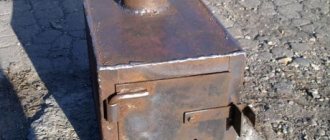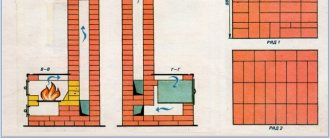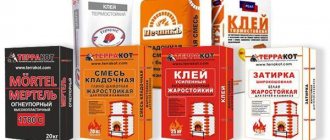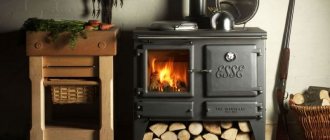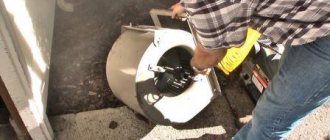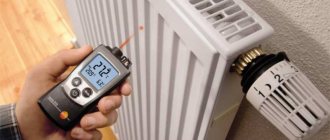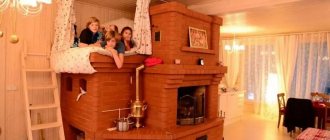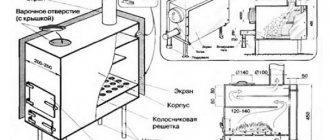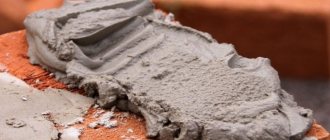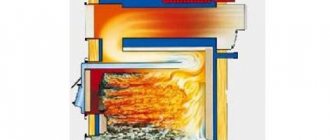How to increase efficiency
When designing or modifying a wood heating system at home, you should remember the basic rule - all elements must be proportionate, optimal and form a harmonious system. A huge firebox with little heat removal will reduce the level of efficiency, and vice versa, excessive heat removal will lead to operational problems.
The concept of “efficiency” means how much energy released during combustion is transferred in the form of heat to the heated room. This characteristic is influenced by a number of factors:
- Serviceability and cleanliness of the stove.
- Type of fuel burned.
- Fuel burning mode.
- Heat transfer method.
- Heat supply efficiency.
- Availability of additional fuel attachments.
Stove serviceability
A significant decrease in the efficiency of the furnace occurs when it is used incorrectly. There are different ways to burn wood, and if you burn it incorrectly, heat energy will be lost.
The soot deposited on the walls of the heat exchanger is an excellent heat insulator. To increase the efficiency of the furnace, you need to periodically, once every 2 months, clean all important parts from soot.
Attention! Soot in the furnace ducts and chimney can catch fire; do not allow deposits to accumulate in the heating system. Soot combustion is a common cause of fires!
The right fuel for your furnace
It is known that different types of wood produce different amounts of heat. You can increase the efficiency of your stove by using the right fuel. Hard types of wood - oak, acacia, ash - have a greater calorific value. In addition to density, an important characteristic is the moisture content of the firewood. Firewood with a moisture content of 15% is considered optimal, but such indicators can be achieved either by using a drying chamber, or by natural drying under a canopy for 2-3 years in ventilated stacks.
Optimal combustion modes
The fuel combustion mode is also important. There are different ways to burn fuel efficiently:
- In the mode of pyrolysis decomposition and afterburning of gases.
- In optimal fast combustion mode with sufficient oxygen access.
- Layered combustion of fuel from top to bottom.
Pyrolysis mode
When burning fuel in pyrolysis mode, the efficiency of the furnace increases due to the long combustion time. The firebox is divided into two chambers - a smoldering combustion chamber, where in a slow mode the firewood decomposes into pyrolysis combustible gases, and a gas afterburning chamber. Technically it looks like this:
- Firewood is placed in the firebox; initially, combustion occurs in a hot mode with the supply of a large amount of air. This stage is necessary to create a fire cushion on the wood, as well as to warm up the chimney and the secondary afterburning chamber.
- The firebox door closes. The air supply is set to a minimum - so that there is enough for smoldering. Firewood decomposes into smoky pyrolysis gases, which pass through a hot afterburning chamber.
- The second chamber has secondary air ducts. They are aimed at a catalyst - a massive red-hot ceramic or metal object. In some furnaces, the wall of the secondary chamber acts as a catalyst.
- Relatively cold pyrolysis gases, passing through the catalyst, are heated, mixed with air and burned.
This ensures complete combustion of the wood. The efficiency of pyrolysis combustion plants can reach 85 - 90%.
Disadvantages of this method of burning wood:
- Difficulty in realizing optimal combustion.
- Impossibility of altering existing fireboxes.
- Cold gases in the chimney turn into condensation, which floods the chimney.
Advantages of this combustion method:
- Duration of work on one tab. In Buleryan stoves, one bookmark is enough to burn for 5 - 8 hours.
- With the correct design of the firebox, the efficiency is high.
- Constancy of generated energy.
Forced combustion
The rapid combustion of firewood in a firebox with a sufficient amount of air will be optimal only if there is a large heat exchanger that can quickly store and retain a large amount of heat. In this case, it is ideal to use water as a coolant, and a large insulated tank as a heat accumulator.
To burn a large amount of fuel in an optimal manner, you will need an ash chamber and a grate. They can be organized in any existing firebox made of two metal plates or bricks. Installing an ash pan in a ready-made firebox will reduce the volume, but will add combustion efficiency.
How it works:
- A large amount of fuel is immediately placed into the combustion chamber, which will burn throughout the entire mass from the bottom up.
- After kindling, the main door closes, the ash pan door opens, and the combustion is regulated.
- The flame should be smooth, hot, without jerks of detonation or pops. The color of the flame is straw with red or blue streaks.
- In this express mode, combustion continues until coals are formed. The ash pan door is closed, the firebox operates in slow mode.
Features of application:
- An oven with a grate can be converted into a hearth by covering the grate with a sheet of metal.
- Brick channels or a massive bell-shaped structure can provide good heat removal. An incorrect ratio between a powerful firebox and a small heat exchanger will lead to a significant amount of heat being “blown out” onto the street.
- You cannot use this mode if there is poor draft - this will lead to smoke inside the room.
- Not every firebox can withstand the heat of burning dry wood. Plain red brick or thin metal can burn or crumble. If possible, use this mode in fireboxes lined with fireclay bricks.
Gradual combustion of fuel
Fast mode with layer-by-layer combustion of wood can be achieved using special air supply systems. This solution is implemented in Stropuva long-burning boilers, but simple fireboxes are quite suitable for conversion.
One or more air ducts made of pipes are inserted into the firebox. Their purpose is to supply air to the combustion site. Air ducts run from the door to the top of the firebox. Slotted holes are cut in the vertical sections of the air ducts. The firebox works like this:
- Firewood is packed tightly into the firebox and can be sprinkled with sawdust or peat. Kindling made of paper and wood chips is lit on top of the bookmark. Until it flares up, the firebox operates in the mode of a conventional deck oven.
- When the kindling flares up, smoothly close the firebox opening with a sealing metal sheet. The sheet has holes for air ducts. The sheet must fit tightly to prevent air from entering the thickness of the fuel.
- The fuel burns using air from the duct. Combustion is optimal, but produces a small amount of heat.
- The fuel burns gradually, first of all burning out near the air duct. If the fuel is burned far from the tube, the air may not reach the combustion site. It is worthwhile to arrange several air ducts evenly, connected to one intake hole.
This combustion method has only one advantage - a long period of autonomous operation. Increased efficiency is achieved thanks to the gradual combustion mode; even a small heat exchanger is able to capture heat and transfer it to the room. This method is perfect for upgrading potbelly stoves and wood-burning boilers, but it is not suitable for brick stoves. An advantage will also be the ease of retrofitting existing fireboxes - anyone can design and manufacture air ducts and a sealing plate from pipes and sheet metal.
Disadvantages of this method of burning wood:
- Difficulty loading firewood.
- Difficulty of kindling.
- It’s difficult to control the intensity of the flame - you can’t open it and “look” at it. You will have to use indirect methods - a thermometer in the heat exchanger.
- Inability to “throw” firewood.
Testing three Russian stoves
The material was found and prepared for publication by Grigory Luchansky
Source: L.A. Semenov, engineer Testing three Russian stoves. “Heating and Ventilation” No. 6, 1941
At the request of Selkhozstroyproekt, in the furnace laboratory of one of the organizations, the author tested: an ordinary Russian stove and, at the same time, two improved Russian stoves - according to the designs of engineer. I.S. Podgorodnkova and T. I.F. Volkova. All three furnaces were placed with the same external dimensions in the laboratory hall and were tested in parallel using the same program.
A total of 27 experiments were carried out, of which the main ones were three for each furnace.
Experience 1
. Firewood consumption - 8 kg. While firing the oven, the following dishes were prepared: 1) meat soup; 2) porridge; 3) jacket potatoes; 4) then 4 kg of white and 2 kg of rye dough were baked.
Experience 2
. Firewood consumption - 16 kg. Prepared: soup, porridge and potatoes in the same quantity. The rye bread was baked in the amount of 12 kg (based on the weight of the dough).
Experience 3.
Firewood consumption - 24 kg. Prepared: soup, porridge and potatoes in the same quantity. The bread was baked rye, the dough weight was 20 kg.
To monitor the tests, the USSR People's Commissariat of Agriculture appointed a special commission consisting of engineer. MM. Kalashnikova (chairman), engineer. M.A. Antonov and tech. F.F. Kavykina. This commission also included a representative from the People's Commissariat of the RSFSR, engineer. E.N. Yurevich. During all tests, TTs were also present. Podgorodnikov and Volkov.
Detailed chronometric records of all work operations were made.
This article provides detailed data only on the ordinary Russian stove shown in Fig. 1. On stoves, vol. Podgorodnikov and Volkov only give the results of the main tests (in the summary table).
As a result of the tests, it was revealed with complete certainty that the ideas about the flow of the combustion process in a Russian stove that have long existed in science and practice are fundamentally erroneous and do not correspond to reality. It was believed that fuel combustion in a Russian stove proceeds with a huge excess of air, for example, according to Stroganov, this excess is no less than 10 (Stroganov “Stove Art”, ed. 1899). In Protopopov’s book (“Kiln business”, ed. 1934) on page 178 you can read the following: “With this method of supplying air, many times more air flows to the fuel than is needed; ...the roof and under the firebox are heated mainly by the radiant heat of the burning fuel, and the combustion products, washing the poorly developed internal surface of the stove and only slightly delayed by the upper threshold above the mouth, carry away with them a huge amount of heat... From here it becomes clear that the efficiency of such a Russian stove cannot to be tall; it usually does not exceed 20% and often drops to 10%.”
Summary table of the results of the main tests of the three furnaces
* Numbers above the line are by the mouth, below the line are by the view.
** After pushing the oven, we waited 1 hour 20 minutes for the oven to cool before placing the bread.
*** After the bread was taken out of the oven, they set the soup to finish cooking.
In fact, the excess air in the firebox is very small, namely: when burning 8 kg of wood a = 2.32; 16 kg - a = 1.66 and 24 kg - a = 1.32, which is within the usual limits for modern ovens.
At certain moments of the firebox, for example, when the mouth of the stove is filled with pots, the amount of air flowing into the firebox is further reduced and its excess drops even to 1.20-1.15.
Apparently, the amount of air flowing into the firebox self-regulates to some extent depending on the intensity of combustion.
Hence, the efficiency turned out to be completely different from that given in textbooks and literature data.
The overall efficiency of the furnace without taking into account the sump was determined:
| along the mouth | by view | |
| 8 kg of firewood | h= 0.72 | h= 0.71 |
| 16 kg of firewood | h= 0.77 | h= 0.72 |
| 24 kg of firewood | h= 0.72 | h= 0.70 |
Separate weighing of unburned small coals and calcination of the ash revealed that losses Q4 (dump) were within 1-2%, so further accurate accounting of the dump was not carried out.
When conducting experiments, it was impossible to accurately take into account losses from unburned hydrocarbons, which certainly occurred, especially at the beginning of the combustion process, when the furnace was still cold. Approximately these additional losses Q5 can be determined within the range of 3-8%.
Hence, the actual efficiency of a Russian stove should be taken on average equal to h = 0.6¸0.7.
Let us dwell on some features of the operation of the firebox of a Russian stove. Due to the fact that the intake of air for combustion of fuel and the exit of gases occur through the same hole, the neutral zone cannot go beyond this hole and is located at approximately 2/5 of its height. This has a decisive influence on the combustion process.
The chimney, which creates “draft” in conventional stoves, has essentially no effect on the combustion process in a Russian stove, and no matter how its height changes, the position of the neutral zone cannot change. The cross-section of the chimney and its height can only affect the amount of air sucked from the room.
Apparently, in a Russian stove fuel can burn successfully even in the absence of a chimney, only then will the flue gases exit directly into the room. The lack of draft contributes to slow and quiet combustion of the fuel. At certain moments of particularly intense combustion, flames protrude from the mouth of the stove and rise up the pipe by 30-40 cm. To avoid this, you should not load more than 10-12 kg of firewood at once.
As a result of the fact that combustion occurs calmly, the gases do not contain fly ash, so that while the fuel is burning, you can cook food in an open container (boil milk, bake pancakes, fry potatoes, etc.).
Due to the fact that the pipe does not affect the combustion of fuel and the neutral zone does not change its position, the pressure under which air enters the firebox depends on the temperature difference between the hot gases in the upper part of the mouth and the room air. The more fuel in the chamber, the more heat is released, the temperature of the gases at the mouth rises higher and, as a result, more fresh air enters the firebox.
This self-regulation occurs most fully at the beginning and in the middle of the combustion process. At the end, when the walls of the chamber are very hot, and when the fuel is burned out, air will flow into the chamber quite intensively, since it can heat up due to the heat accumulated by the walls of the chamber. The latter forces you not to hesitate in closing the stove after, due to the state of the coals, this can be done without fear of carbon monoxide being released.
Rice. 1. Ordinary Russian stove
It should be noted that at the end of the combustion process, when only the coals burn out and air continues to flow through the completely open mouth, the excess of the latter is still not very large and the CO2 content in the exhaust gases at the mouth does not fall below 7-8%. Apparently, this is explained primarily by the fact that the air supply is somewhat reduced due to the above-mentioned self-regulation. But it's not only that. In a Russian stove, due to the absence of grates, coals burn out relatively slowly and by the end of the firebox a large amount of them accumulates. At the moment when the firewood is burned and only the remaining firebrands burn out, the coals are scattered in large quantities over the hearth. And due to the combustion of coals, a fairly high CO2 content is maintained. As a rule, the coals are not allowed to burn out, and as soon as the release of the “blue light” ends, their entire mass is raked to the sides and the mouth of the furnace is closed with a damper.
After this, the chamber is completely isolated. Air can only flow through the cracks at the damper, and the neutral zone does not extend beyond the damper and therefore the available pressure is negligible in size. As a result, the chamber of a Russian stove, all other things being equal, has better thermos properties compared to fireboxes of the conventional (flow-through) type.
In furnaces with flow-through fireboxes, the chambers suffer more from the leakage of cold air through leaks in the combustion and ash doors and valves. Even if we assume that the valve and the view are perfectly tight, then air will still leak through the chamber if it has a separate firebox, which is located below the chamber, as is the case in Russian TT stoves. Volkov and Podgorodnikov.
Maintaining the temperature in the chamber of an ordinary Russian stove is also facilitated by the fact that after heating there is always a lot of coal left in it, which then burns out in the “burning” of the stove.
One of the main disadvantages of the Russian stove is the inability to burn fuels such as coal in it (due to the lack of a grate in the firebox).
Cooking food
in a Russian oven is very convenient for the following reasons:
1. It is easy to observe and manipulate the pots due to the fact that the chamber is well lit and its mouth is always open.
2. The fuel burns quietly. The chamber has zones with high temperatures - near the fire itself, and zones with lower temperatures - in front, at the mouth and on the sides, which makes it possible to regulate the degree of boiling of food. The absence of a damper at the mouth of the chamber is a great convenience for the housewife - at any time she can take out any pot, inspect it, and stir it.
3. The presence of coals on the chamber floor and the absence of a damper allows you to fry all kinds of dishes and seasonings (meat, onions, potatoes, lard, etc.) in a frying pan and bake pancakes, pies, etc.
4. Since the fuel is burned directly in the chamber, and its combustion occurs with a fairly high efficiency, and all the heat is absorbed by the walls and roof of the chamber, even with a relatively small amount of it it is possible to prepare dinner and bake bread. The chamber underneath also heats up quite well from the coals burning on it.
Thanks to these features of an ordinary Russian stove, it was possible to cook dinner and bake wheat bread in it using only 5 kg of firewood (which was not possible to do in other stoves).
An ordinary Russian oven also gave good results when baking bread. Baking 1 kg of bread in it required only 0.3 kg of fuel, while Comrade Podgorodnikov’s oven required 0.53 kg, and Comrade Bazhov’s oven even 0.70 kg.
Heating the premises.
When evaluating stoves as heating devices, we proceeded from three conditions: 1) the efficiency of the stove; 2) the coefficient of heat transfer unevenness and 3) the nature of heating of the furnace along its height (“temperature profile”).
Modern heating stoves under laboratory (ceremonial) test conditions give an efficiency of 0.75-0.85. But it should be taken into account that these same furnaces, under practical operating conditions, significantly reduce efficiency due to a number of factors, namely:
1. Incorrect operation of the firebox. Experiments have shown that if, for example, you heat a stove with the combustion door open, the efficiency drops by about 20%.
2. Cold air leaking through the oven due to a loosely closed pipe. These losses are always present and are usually estimated at 5%, although no one knows their actual value in practice.
3. Chipping of seams in the masonry of grooves between chimneys and leakage of hot gases during the firing of the stove along a short path into the chimney.
4. Gradual accumulation of soot on the internal surfaces of the furnace, as a result of which the heat absorption coefficient decreases and the temperature of the exhaust gases increases, and consequently, losses into the pipe.
Due to the presence of the listed phenomena, the efficiency of furnaces in practice for the best furnaces on average is hardly more than 0.5-0.6.
In an ordinary Russian stove, the factors listed above are almost completely absent, and therefore a particularly significant decrease in efficiency in practical work (compared to laboratory test data) cannot be expected. We think that the efficiency of a correctly built Russian stove should also be 0.5-0.6 under operating conditions.
Heat transfer unevenness coefficient ( m
), determined by the formula
m=(Wmax—Wmin)/(2Wav)
turned out to be in the range of 0.30–0.35, which corresponds to massive furnaces with high heat capacity.
The temperature distribution over the surface of the furnace along its height has a significant impact on the temperature distribution along the height of the heated room.
An ordinary Russian stove has 12 more rows of masonry below the hearth. With daily heating, several rows below the hearth warm up, but very weakly, and 5-6 rows no longer warm up at all.
The heat given off by a Russian stove is distributed approximately (roughly) as follows: 1) the side walls give 55%; 2) furnace overlap - 25%; 3) over-pipe - 20%.
From these figures we see that almost 50% of the heat is generated beyond human height, with radiant heat from the ceiling essentially heating the ceiling.
Thus, the Russian stove does not meet modern requirements for heating devices.
Thermos properties.
With the same fuel consumption for the first 12-20 hours. the temperature in the chamber of an ordinary Russian stove remains higher than in the chamber of Comrade Volkov’s stove, and only at the end does it lag somewhat behind (by 5-15°). If in the summer the stove is heated at 3 o’clock in the morning, and the family has dinner at 9 o’clock. evening, then the time period is 18 hours. Before this period, with a fuel consumption of 8 and 16 kg, the temperature in the Russian stove is even higher than in other stoves. When burning 24 kg of wood, it is 10° lower than in Comrade Volkov’s stove, but its absolute value is more than sufficient (90°).
Of greatest interest is the ability of furnaces to retain heat at low fuel consumption. The uneven nature of the temperature curve for an ordinary Russian stove is apparently explained by the presence of a small amount of hot coals in the chamber.
Ventilation properties.
Due to the fact that fuel combustion continues for quite a long time, the cooking of dinner almost completely ends even when the stove is fired, and therefore all the gases and vapors released during cooking fly into the chimney along with the combustion products.
It should be noted the excellent ventilation properties of the Russian stove. When fuel burns, a large amount of room air is sucked into the head. For every kilogram of burned wood, up to 22-26 m3 of air is removed from the room. The stove is always heated early in the morning, and this regular daily ventilation creates a clean and dry atmosphere in the hut. Only in winter cold does the exhaust through the pipe decrease due to the fact that the windows and doors are tightly closed and the outside air is sucked into the room with great resistance.
Fire safety.
In this part, the Russian stove has one significant drawback - the possibility of sparks flying out of the pipe when mixing firewood. The latter is especially dangerous with a straight pipe, without a twist.
In the laboratory there was a furnace with a cover that acted as a spark separator, but this did not give 100% effect.
The advantages of the Russian stove include the deep location of the firebox, in front of which there is a platform (“pole”) about 57 cm wide. The presence of the latter prevents the possibility of coals falling out of the firebox during combustion.
It is worth noting the simplicity and convenience of pouring firebrands - it is done directly on the hearth, while in other furnaces they have to be pulled out of the firebox.
The complexity of the device and the need for scarce materials.
Due to the absence of any channels hidden in the body of the masonry, the design of the Russian stove is very simple. It should still be noted that in order to obtain the desired effect, the stove must be folded correctly - in relation to the height and other dimensions of the chamber. It is made of ordinary bricks with clay mortar. Due to the low tension of the combustion chamber and the low temperature of the firebox, ordinary clay bricks can serve for many years without any repairs.
The need for a set is minimal: 1) a damper for the chamber made of roofing iron and 2) a valve.
Back to section
Heat removal optimization
You can increase the efficiency of your heating system by removing a large amount of heat and transferring it into the room. You can do this in two ways:
- Infrared radiation - from a burning flame or hot walls.
- Heating air or water in the firebox.
Hearths were traditionally heated with open flames in Europe. A fashionable fireplace has a low efficiency, but it only uses infrared radiation. The light of a burning flame in conventional stoves is used to heat the walls of the firebox. In most cases, heating the firebox is not beneficial. You can use part of the heat emitted during bright combustion with a transparent door of a large firebox. You won't be able to use plain glass - it might break. Heat-resistant glass is inserted into the doors.
Heating-type stoves have proven to be effective. The Winter Palace, the Hermitage, and the Arsenal were heated by Uttermark stoves. The burning fuel heated the pipes in which the air moved. Such heating made it possible to obtain fantastic results in terms of speed and efficiency. By laying dry pipes in the firebox, you can quickly warm up the room with dry warm air. In residential premises, you can use forced air supply, influx from the street and humidification. This way you can control not only the temperature, but also the humidity, as well as the amount of carbon dioxide. The downside is the difficulty of implementation in ready-made brick kilns.
By inserting a central heating circuit into the furnace, you can increase heat output and effectively transfer heat throughout the building. In this case, an increase in heating efficiency is achieved by increasing the heat exchange area; less heat escapes into the pipe.
Selection of oven
Central heating, especially for a separate house, is today a rather expensive pleasure, which is also supplied intermittently. Therefore, many people buy ready-made stoves, trying to choose models that combine excellent performance characteristics, reasonable cost, and, of course, high efficiency. However, solid fuel stoves are considered less efficient than gas stoves because they have a low efficiency. At current prices for coal, peat, fuel oil or firewood, the cost of heating a building will be high, even higher than for central heating services - unless care is taken to purchase or build a high-efficiency stove.
What stove models should you consider when choosing? If the financial side of the issue is decisive for the choice, then let’s take a look at domestic models, since foreign analogues have a higher price, using the same principle of fuel combustion. These will be heating stoves such as “Professor Butakov”, “Teplodar”, “Varvara”, “Termofor” and the like.
Oven "Professor Butakov"
These models are distinguished by high efficiency, since heat loss through smoke is minimized in them, the uniformity of the combustion process is adjusted, and there is practically no under-combustion of the fill and CO.
You need to focus on the design of just such stoves if you plan to design and build a stove yourself. In any case, you can’t do without a ready-made project; you will need to use not only brick to build the stove, but also sheet steel, preferably at least 4 mm thick - so why reinvent the wheel if they will soon stop producing it?
We build a furnace with high efficiency
Let's look at examples of building furnaces from scratch, in which the approach to increasing efficiency was brilliantly implemented.
Kuznetsov brick bell furnace
The efficiency of this furnace is increased by complete and hot combustion of fuel, secondary combustion of pyrolysis gases, free movement of gases, and a large heat exchange area. The large mass of bricks perfectly accumulates and retains heat. The bell-type design is popularly called “greedy” - the temperature of the exhaust gases is lower than that of conventional channel furnaces.
To build such a stove, you need to follow the following steps:
- We are preparing a stove project. Ready-made projects are freely available and can be modified to suit your needs.
- Preparation of tools and materials. A mason's hammer, a trowel, a level, a plumb line, an angle grinder with a diamond blade - you don't need anything else to build a brick kiln. We buy red stove bricks and refractory fireclay for lining the firebox. The temperature in the firebox can rise above 900 degrees, and the red brick may well crumble. It is better to choose cast iron doors, with seals and glass. Clay can be dug up in a nearby quarry and mixed with sand.
- We are preparing the foundation. To do this, we determine a place, dig a pit and fill it with rubble concrete. The upper level of the foundation should be 14-15 cm below the floor level. It is better to place the stove in the center of the house; be sure to calculate the passage of the chimney through the ceilings.
- We lay the first rows of the stove on cement mortar, the rest of the stove is placed on clay. We lay thermal insulation and waterproofing between the brick and the foundation. The first row is the most important; all planes of the oven will be oriented along its corners.
- We tie up the ash pan and side channels. We take into account the size of the doors for cleaning. If they are not there, we lay the brick on its edge, it will be knocked out.
- We cover the ash pan and lay the first row of fireclay. We place a cast iron grate under the firebox, under which a groove is selected in the brick with a gap of 1.5 cm.
- We line the firebox with refractory bricks. We provide a gap between the fireclay and the red brick. It is convenient to lay the packaging cardboard as a template. Fireclay is placed on fireproof mortal clay. When laying fireclay, a dry seam is made at the back wall - masonry without mortar with a gap of 1 cm. It is needed to facilitate kindling and access of secondary air.
- We lay out the walls of the furnace and make the moves. We install the door on anchor plates or wire.
- We close the firebox and form the first cap. We control the level of all horizontal and vertical planes. We rub the seams from the inside with a damp mitten.
- We lay out the second cap, cover it with two rows of bricks - a roof.
- We remove the chimney. It is best to use a straight brick pipe, lined and insulated with perlite.
- We dry the oven for 2 months with the cleaning doors open, and then put it back into operation with frequent but small fires. This is necessary to prevent the oven from cracking.
- To increase the efficiency of the heating system, a heat exchanger made of pipes can be installed in the first cap. The heat in the hood lasts for a long time, so the coolant will heat up inside the massive furnace for a long time and evenly.
Kuznetsov's bell-type stove is a bright representative of the principle of rapid combustion of wood, accumulation of heat in the stove mass and its gradual release from the heated walls by infrared into the room.
The Buleryan furnace is the leader in efficiency among metal furnaces
Long-burning metal stove "Buleryan". The high efficiency of this furnace is ensured by the pyrolysis combustion mode; the furnace of this furnace consists of dry pipes. The temperature of the gases leaving the air heaters does not exceed 150 - 200 degrees, the air does not burn out and does not dry out. If Buleryan is heated incorrectly, in a hot mode, its efficiency can be compared with any potbelly stove.
To build Buleryan we will need metalworking skills and the ability to make sealed welds. Accordingly, you will need a welding machine (preferably a semi-automatic MIG), an angle grinder, a plumbing and measuring tool. You will need a pipe bender to bend the pipes, but this can be replaced with a large lever.
- Materials for the stove are not difficult to find - you need 10 - 14 pieces of pipe for the frame, sheet metal, blanks for the door and hinges.
- The first step is to weld the frame from pipes bent according to a template. It turns out to be a kind of “chest”; the spaces between the “ribs” need to be hermetically sealed.
- A shelf of the secondary chamber is installed inside the resulting frame. We measure it using a cardboard template, bend it and weld it. After we weld the last ribs, secondary air tubes are laid.
- We dampen the ends of the resulting cylinder, remove the chimney from the afterburning chamber, and weld a round door at the front end. We seal the door joint with a lock filled with asbestos cord.
- We attach damper regulators to the chimney and air intake.
- The oven is ready for installation. When connecting, it is important to remember that the chimney can become very hot. A slow fire can lead to the formation of condensation, so it is better to use a lined stainless steel chimney.
The Buleryan stove is a prominent representative of long-burning calorific stoves without a heat accumulator, with rapid heat transfer to the air. It needs to be heated in pyrolysis mode, with minimal air supply.
Experimental folk methods for increasing efficiency
There is information that the efficiency of the furnace can be increased if heated steam is supplied to the fuel combustion zone. The burning of water is a controversial phenomenon and is surprising. Users of water combustion systems claim that heat output increases by 20%. The nature of the phenomenon is as follows: water is supplied through the firebox into the fuel combustion zone.
The high temperature causes the water to decompose and burn again, which adds temperature to the firebox and saves gas.
You can increase the efficiency of a wood-burning stove by making a rocket-type fuel attachment. Combustion in such a firebox occurs at the bottom; the firewood is installed horizontally and falls under its own weight into the combustion zone. The combustion is bright and occurs due to draft. Users of such fireboxes claim that they save wood and have a long self-burning time.
Types of wood-burning brick ovens
In a Dutch oven, the walls are thinner, so they heat up faster
There are several most common types of stoves. They differ in structural features, dimensions and functionality.
Dutch oven
The Dutch design is distinguished by the vertical placement of channels, the walls are thinner than those of other varieties. Thanks to this, the walls of the room are quickly warmed up by hot smoke. The fuel does not burn, but slowly smolders inside. Thanks to long burning, the need to load a new portion of firewood occurs less frequently. Long breaks between fires do not lead to a decrease in power. For successful operation, the stove must be regularly cleaned of ash accumulations and soot. The one who serves the Dutch oven must be able to carry out kindling: the view must be kept closed, otherwise the walls will soon cool down.
The unit has small horizontal dimensions (for example, models with a meter width and length are often found), and can be of different heights. Its small size makes this wood-burning brick stove suitable for a summer house. It will be able to heat a room of up to 70 m2. A tall structure extending through the ceiling can serve a two-story house.
The Dutch oven can be equipped with additional devices - a hob, an oven or a tank for heating liquid. Such a multifunctional installation is suitable for a country house in an area where there is no electricity, also acting as a stove and allowing you to prepare steamed and baked dishes, dry vegetables, mushrooms, and berries. In this case, it is better to install a small stone stove in the bathhouse.
Russian stove
The Russian stove is a multifunctional device, but it is large in size and requires costs for materials
The largest option. The design has an open firebox, which is blocked from time to time by a damper. In terms of versatility, such an oven is not inferior to a Dutch oven and can be used for preparing hot dishes, baking bakery products, drying berries, vegetables, fruits and mushrooms. In addition, you can dry your shoes on the stove; some models are also equipped with a bench. When used in summer for cooking, you need to open a special channel that communicates with the chimney. The smoke masses are directed through it to the street. The stove can be painted or decorated with facing tiles. Not all materials are compatible with a unit that maintains a high temperature.
The main disadvantage of this option is the bulky and massive design. Construction requires a solid foundation and large amounts of materials. The stove also needs regular lighting and cleaning of the passages. If you do not heat the unit for a long time in the cold season, due to a temperature jump, condensed moisture will begin to settle on the walls. Repeated absorption of this liquid by a brick does not at all lead to an improvement in its performance. This material is prone to crumbling.
Swedish stove
The peculiarity of the Swede is the ability to heat two adjacent rooms
Compared to the Dutch, the Swede has a better efficiency indicator and uses fuel more efficiently, but it will not be able to completely heat a two-story house. Its design is designed to serve two rooms located next door. To heat the remaining rooms, additional equipment will need to be installed. This stove is also suitable for a summer house.
The internal device has a system of several moves. The principle of operation is also similar to bell-type models, when flue gases burn out under the combustion vault. The design of the furnace unit ensures good heating of the floor. The Swede can be equipped with a fireplace, oven, hob, and a compartment for drying things. The disadvantages include the need for materials with increased fire resistance for the manufacture of some parts (because of this, construction will cost more) and thermal insulation equipment that prevents heat loss in the lower part.
Additional factors for improving heating in the house
You can improve the heating of your home not only by improving the firebox and heat removal. By reducing the heat loss of a building, more significant results can be achieved. Installing high-quality windows, insulating floors and walls, installing an air recirculation and recovery system is sometimes cheaper than redoing the heating system.
When improving heating, you should use only proven methods for improving fuel combustion. In this case, it is better to calculate the savings and funds spent on refurbishment.
